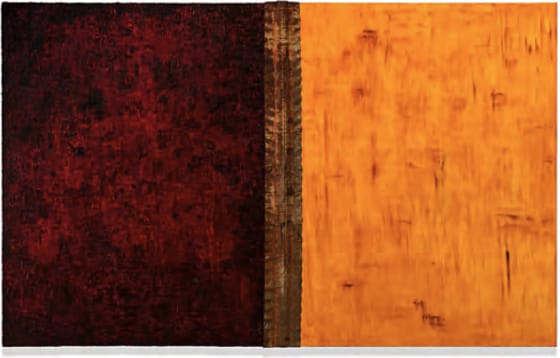A generation ago, in the latter third of the twentieth century, post-modernist deconstructionists were finished with abstraction. It was dead, they said, along with painting itself. But in the intervening decades, two things happened. First, this deconstructionist idea became entrenched in academia, and second, it was proven to be wrong beyond any shadow of a doubt in studios, galleries and museums.
I bring this up because of the way that the spectacular Harmony Hammond: Becoming/Unbecoming Monochrome (which is rapidly coming to a close) at RedLine makes the point. Hammond, who lives in New Mexico, has created a body of abstract paintings over the past five decades that are at least as relevant to current ideas about making art as the controversial Aspen Art Museum piece that featured tortoises with iPads strapped to their shells. Actually, they are more so, because unlike the tortoises, Hammond's paintings are both smart and tremendously beautiful.
The RedLine show was ably curated by art historian and queer theorist Tirza True Latimer, who collected some of Hammond's works from the '70s and used them as the obvious sources for her work of the last few years (though the earlier pieces are notably smaller than the mostly monumental newer ones).
Hammond is a feminist and a lesbian, and she's used these facts to inform her work, which is decidedly abstract -- a sensibility that some have labeled patriarchal. But Hammond disagrees. "I don't accept that painting is an over-determined site, a privileged domain of the authoritative masculine voice," she writes in the show catalogue, adding that her paintings "come out of post-minimal and feminist concerns about materials and process."
In a prelude to the show, she proves it via a display case with Native American baskets made by women alongside her responses to them. For Hammond, this provides a female origin for her post-minimal "woven" paintings, which she did in the 1970s and which clearly anticipate her recent efforts. In these early works, many of which are on lozenge-shaped panels that recall skateboards and snowboards, Hammond built up the surfaces with thick layers of mostly somber-colored oil paint blended with wax. While the layers were still wet, she worked the paint with the back end of her brush so that in an all-over arrangement, the colors from the lower levels are revealed on the surface -- hence the reference to baskets, as the different colors are "woven" into one another.
These early works are marvelous, but the newer ones are positively magisterial, their somber and elegant presence literally taking over the multi-part spaces at RedLine. Hammond has pointed out that these large monochromatic panels aren't truly monochromes -- a fact that becomes clear when you examine them up close. For instance, a big black panel turns out to be an array of deep greens, with lighter shades being revealed here and there through Hammond's working of the paint. Many of the monumental works include ready-made elements that have been embedded into them, including straps with grommet holes, bits of rope, and push pins.
Several set up a duality with either vertical or horizontal divisions, as in "Suture," a masterful diptych. There's a dappled deep red with black accents on the left, and a mellow orangey yellow on the right; a found bit of ceiling tin runs vertically down the panel, marking a clear division between the two.
Hammond's show reminded me of other women artists active in the West who played with geometric abstraction, minimalism and post-minimalism during the mid- to late twentieth century. They include Agnes Martin, Janet Lippincott, Mary Chenoweth and Dorothy LaSelle. So not only do Hammond's works demonstrate that non-objective formalist abstraction belongs to women as well as men, but our region's art history proves it, too.
...
Read full review at westword.com

